
Category Archives: habits


The Gratitude Issue
Gratitude is what's on my mind right now. We're at that annual cusp from old year to new. That time when so many people make resolutions, often unrealistic and undefined. And by doing so set themselves up to feel bad about themselves later. There are a number of studies that show how beneficial a gratitude practice can be, mentally, emotionally, and physically, to support our overall health and wellness.
The gratitude jar
I believe anytime is a perfect time to think about gratitude. But I especially love this ritual that I've built up over time around creating an abundance of gratitude in my life.
For the past few years I've had a jar sitting next to my desk in my office. When I have a moment of gratitude (and it can be for anything, not specifically for work, personal, others in my life) I write it down on a little scrap of paper and throw it in the jar. I confess that I try to find colorful scraps of paper because it's more fun that way. I don't go back through the jar throughout the year, I just keep filling it up.
Come New Year's Eve while I'm waiting for the countdown, I open the jar and empty it out. I unfold all those pieces of paper and savor reading them one by one. I do this by myself, but you may choose to do it with friends or family members too. It can be fun if it's a group jar or if several people bring their jars and go through them together.
I find I do remember many of them, but what always strikes me is the number of things that I forgot about. Every. Single. Year. These are moments I was grateful for when they happened, but in the hustle and bustle of everyday life they slipped into the back of my memory and got buried there. In opening this jar and going through them, I am grateful for those moments again.
Some people write all of their gratitudes down in a book that they keep from year to year. I have another friend who glues down all her little scraps into a composition book of gratitude. I don't do any of those things, mine go into the compost bin. But I truly love this ritual look back over the year. This ability in spite of any challenges or low moments we may have faced to see so many wonderful things. So many reasons to be grateful.
Once the jar is empty it almost seems to sparkle as I set it next to my desk to begin again. And it brings hope and a cheerful spirit as I anticipate the year ahead.
Cultivating a habit of gratitude
Being grateful doesn't always come easy. For some reason we are surrounded by a culture (and a news media) that brings out the worst in us. Often we get so overwhelmed that we allow the negative things to strongly influence how we percieve what is happening around us. Amidst the explosions of stress, worry, and overwhelming circumstance, the little sparks of gratitude can sometimes get lost. Just as we learn to read and write and do any of the other things we've learned to do in life, so too we need to learn to cultivate the habit of gratitude.
Below are some of my favorite resources and articles on the topic. I am not going to lie and tell you that I live in that blissed out place that is continual gratitude. I don't. I sometimes struggle to get there, to get anywhere close to being grateful. And yet I know I have to very much to be grateful for.
Yes we can get overwhelmed, sometimes we get lost. But I have come to believe that by remembering that concept of gratitude and by trying to pay attention to it I am happier overall. And so I've collected these resources and I have my ritual of the gratitude jar. I'm excited and looking forward to what this new year will bring.
As we transition to another year I hope that whatever the year ahead holds for you it also brings happiness, health, contentment, and peace.
Gratitude resources
How To Be Grateful To People We Don't Like – Learning to look at negative situations and focus on the good things we have can help us achieve a transformational shift. Admittedly this is not always easy to do, but sometimes having a resource we can turn to the guide us toward this can be helpful.
Gratefulness.org – A wonderful website offering videos, audios, articles, a virtual labyrinth, and virtual candles you can light. This is one of my favorite resources.
How Gratitude Can Change Your Life – A good article about gratitude with some information about how studies showing how it can improve your life.
Why Living a Life of Gratitude Can Make You Happy – A few suggestions for ways to add a gratitude practice to your life.
Stumbling Toward Gratitude – The end of this article sums it up well, ” There are no miracles. … There are no long-term quick fixes for happiness, so if you become a more grateful person and you add [these] exercises to your repertoire, you’ll be different six months or a year from now.”
9 Ways To Cultivate Gratitude – Nine suggestions for ways to cultivate gratitude (and avoid focusing on criticism or complaints)
A Serving of Gratitude May Save The Day – This New York Times article has some great suggestions and offers gentle ways to get started
And here's a video on gratitude that I found moving. Thanks to my Aunt for sharing it just when I needed it.
Gratitude: A Mindful Pause – if you happen to be in the market for a sweet gratitude journal. This one has both unlined and lined pages making it perfect for both writing and drawing, coloring, or art journaling.

10 Common Anxiety Triggers And How To Overcome Them
In our modern society, we’ve somehow become convinced that if we can just juggle all those balls or spin all those plates, life will be perfect. Unfortunately, so many of the modern inputs actually contribute to stress, overwhelm, and even anxiety or depression. There are several things in our lives that can cause anxiety. There are a number of different things that can help alleviate many of these stressors.
1. Lack of Sleep
We try to do more in our day, and sleep is the first to go. Unfortunately, in our desire to get more done, sleep deprivation can instigate or worsen anxiety disorders. By making sleep a priority you just might find you are also more productive. There are several things you can do for improving your sleep. Check out my post “How to Sleep Soundly” for several tips.
2. Excessive Technology
Digital overload is now the norm in our society. Cell phones, computers, and televisions all keep us “connected.” There are texts and emails that bombard us throughout our day, shows to watch, and video games to play. But what is the cost of all this technology? There is an overload of information that we must process, and this can activate stress hormones and the brain is constantly “on”, leaving us anxious. For many it can be beneficial to set aside some time each day with no technology. You might be surprised how less anxious you feel.
3. Too Much News
This is another challenge that comes along with technology. Social media sites cover more negative or dramatic news to encourage more hits. Have you heard the term “doomscrolling”? This is where you get sucked into a negative news cycle and find it difficult to disengage. All types of news media consumption can increase emotional distress. Some strategies to limit this type of stress can include turning off smartphone news notifications, set time limits for scrolling, and add other tech-free periods during your day.
4. Being Disconnected From Nature
Our connection with nature is slipping away as we spend more time on devices. American adults spend more than half of their day on electronic media; and the average adult spends five hours or less in nature per week. The environments we are in can increase or decrease our stress and this in turn impacts our overall health. Being in nature reduces anger, fear, and stress. Consider taking walks or hikes during your day, even a short walk can help lift your spirits. Forest bathing, spending time in a forest, lowers cortisol levels, reduces blood pressure and pulse rate.
5. Sedentary Life
Sedentary lifestyle has definitely increased with our technology use and lack of time in nature. It too can affect mental health issues such as depression, anxiety, and self-esteem. It is important to move throughout the day. If you sit for long periods of time, consider setting a timer for every 30 minutes to just get up and walk around or stretch for a few minutes.
6. The Blood Sugar Roller Coaster
Experiencing the blood sugar roller coaster not only impacts your body but also your mood. Unstable blood sugar often starts with a lack of protein and nourishing foods at the beginning of the day. As you go through the day your blood sugar begins to spin out of control. These ups and downs can produce anxiety, worry, and irritability. To avoid this roller coaster, concentrate your meals and snacks around protein, fiber, and healthy fats.
7. Lack of Purpose or Doing a Job You Hate
Feeling of not having a clear direction or goal in life and/or job burnout can impact your overall mental health causing problems with anxiety and depression. You may not be able to quit your job right now, but you can invest your time in doing something you are passionate about. Even a couple of hours a week doing something you love can help lift your mood. And who knows…sometimes these passion projects can lead to a new career!
8. Bottling up Emotions or Unprocessed Trauma
Emotional suppression and unresolved emotional distress have been shown in studies to contribute to anxiety. Post-traumatic stress disorder (PTSD) is an example of unprocessed trauma. Yoga, meditation, mindfulness, exercise, journaling, and reaching out to someone are all strategies that can help.
9. Lack of Deep Connection
Lack of meaningful and authentic relationships in one's life can increase the risk of anxiety and depression. Humans are social beings. As the saying goes, “No man is an island.” Some people may need differing levels of connectiveness, but we all need some form of human contact. Suggestions can include reaching out to someone, to get involved in something you feel passionate about, replace screen time with face-to-face time, or join a walking group. Building relationships not only helps you, it can help others too.
10. Being Over Caffeinated
Consuming excessive caffeine can trigger anxiety. Caffeine is found not only in coffee but also tea, energy drinks, candy, and more. You can check out my post “How Much Caffeine Do You Need?” To limit caffeine intake, read labels to determine how much you may actually be consuming and find alternatives that don’t contain caffeine. If you feel you need a “hit” of caffeine try a glass of water, take a walk, or practice deep breathing – all of which can improve your energy level.
With so many areas that can cause anxiety in our lives, it can be challenging to reduce it. Yet, implementing some of these strategies can still be helpful.

Decluttering: What Not To Keep
Where to start
If you're like me looking at a big pile of stuff is so overwhelming that it can be hard to know where to begin. Without a focal point of some kind, it's easy to get overwhelmed, Then you do something, anything else, in an effort to avoid the brain chaos of having to figure out how to wade through everything. Over the years I've come up with a plan that really works for me. These are my top 12 declutter categories and a great place to get started. Hint: you don't have to do it all at once. You can simply pick one thing per month and when you're done decluttering that category you're done for the month. Taking it one step at a time and having a clear-cut plan makes it super easy to not be overwhelmed. It also gives you a framework and helps you stay on track.Here are my top 12:
1. Clothes you no longer love
Let's be honest, we all have them. Something in the back of the closet that doesn't fit and you're holding on to it in the hopes that one day... Let it go. If you change size, you deserve to get something new. Or you've got clothes that don't make you feel good when you wear them. I know, it's hard to let go when you've paid good money for it. But I believe you deserve to look fabulous in whatever you wear.2. Kitchen appliances you haven't used in years (fondu pot I'm looking at you) –
The kitchen is one of the easiest areas to build up clutter. And often, because it's behind a cabinet door, you don't see it until you open the door and everything springs out at you while you're looking for a pot lid. Make your life simpler, just keep what you need, and resist the urge to buy that new tangine dish. Take your kitchen decluttering one step further and download my free Kitchen Cleanout Checklist.3. Old cell phones
Why do we hang on to these? If you've got one working cell phone chances are you don't need two non-working ones. This is a great opportunity to help someone else. The National Coalition Against Domestic Violence (NCADV) is an organization that can refurbish cell phones or responsibly recycle them with the funds going to help victims and survivors of domestic abuse.4. Old Magazines
If you haven't read them in over a year chances are you're not going to. Even if you have read them, how many magazines do you need cluttering up the house? Two great recycling options for magazines are your local Friends of the Library which sells them for just a few cents or see if an art teacher at your local school can use them for supplies.5. Chipped mugs and dishware
I know, it's hard to let go of your favorites. But if you're always drinking out of only one spot because otherwise, you're going to cut yourself it's time to find a new favorite mug (from the mugs you already have). Mugs and dishware can be repurposed into super cute plant pots, but otherwise, just let them go.6. Extra vases
How many vases do you really need? Go through that vase collection clinking around in the basement or the back of the closet and pare it down to just a few. Donate any extras back to your local florist, they'll appreciate the recycling effort and you'll clear out a little space in your home.7. Orphan socks
I know, how does that happen? Two socks go into the dryer, one sock comes out. Sometimes I swear they must be turning into dryer lint. If you've got a collection of orphan socks and it's been a year or longer, chances are that other sock is never coming back. Since single socks are difficult to donate have some fun and make sock puppets.8. E-junk
We've all got it. That collection of cords, old power packs that go to who knows what, the wires that you can't identify, and plugs that don't fit anything you currently own. This category also includes old cameras (your cell phone is probably better), and other old e-tech. See Item #3, donate the tangled mess, and get it out of your house.9. Sniffy candles and soaps you don't like
Just because it was a gift from someone else doesn't mean you need to keep it. Offer a polite thank you and don't allow these things to accumulate in a drawer. Either regift, offer up at a white elephant party or donate to charity.10. Water bottle clutter
Unless I'm mistaken you only use one water bottle at a time. So why are there 15 of them hanging out in the cabinet under the toaster? Figure out which ones work best for you and give away the rest. Also...resist the urge to buy a new pretty water bottle when they all go on sale in January.11. Craft clutter
I'm so guilty of this one. Not that I buy a lot of craft supplies, but I have a hard time when it comes to yarn and paper. And if someone's giving it away I'm usually first in line with my hand out. I've learned to limit the amount I have by keeping a specific container for each. If it's going to overflow the container then something needs to go. This works for any craft – sewing, painting, jewelry making, ceramics, whatever it is figure out how much room you want to allocate to your craft, and don't give it any more room than that.12. Partial containers of shampoo, lotion, etc
I've never been able to figure out how this happens but somehow there's always a bit of clutter when it comes to these items. Be realistic about if you're going to use it or not. If you are, make a concerted effort to use all of it. Otherwise, let it go.Two final thoughts about decluttering:
- It's okay to have empty space in your home. Just because you cleared some space in a closet or drawer does not mean you need to fill it up again. Take some time to live with it just as it is and see if you feel okay living with less.
- When donating things you don't need anymore if you're one of those people who cannot drop off at the back of the charity shop without then going around to the front to explore, consider calling a charitable organization in your area to see if they will pick up. Many of them will come to you if there is enough stuff. This might be a good time to reach out to your neighbors and see if they're decluttering too.

Overwhelmed By Bad News?
I read this share in social media. I love this sentence, “I learned a long time ago to not see the world through printed headlines.”
I find myself regularly reminding clients, and myself, that the media, just like any other business, is a business. Dollars depend on eyeballs. Whoever screams the loudest and shares the scariest stuff makes the most money. Our nervous systems and our mental health are paying the price for this.
It’s not easy, but we need to learn to shift our attention. These days I am doing a news fast three, sometimes four times a week. Believe me it’s still gets in, but I’m not nearly as overwhelmed.
I find it helpful to connect to the positive. I’m so grateful for my friend Bill who once a week sends an email with good news from around the world. And I love my small circle of friends who send each other funny things on a regular basis. Laughter is such a good thing.
We also need to remember to focus on the good things. The weddings, the babies, the joys and successes of others. The hard things? The challenging things? I’m not saying to ignore them, but don’t make them the centerpiece of your reality.
Don’t give into the media maelstrom.
I’ve also been spending more time in nature and highly recommend that. Sometimes just sitting outside listening to the birds and the insects. Watching the butterflies. Looking at the clouds. This is not being lazy, this is self-care and nurturing. I feel like we all need a little bit more of that.
How do you nurture yourself and “write your own headlines”?
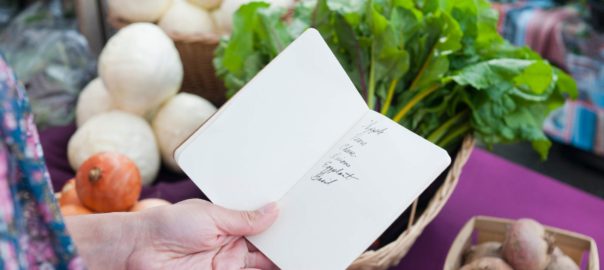
Realistic Food Budget Tips
With the rising cost of groceries many people are beginning to look more closely at their grocery budget. Unfortunately costs are probably going to continue for a while due to supply chain shortages and reduced resources.
Although you want to save money on groceries this is not the time to revert to buying poor quality food solely to reduce your costs. You still want to make sure you are nourishing your body and eating as well as possible.
The idea of reducing your food budget needs to start with knowing where you are and what you’re actually spending. You can calculate your family’s current grocery amount using the USDA Official Food Plans: Cost of Food at Home chart. Once you know what your amount is you can begin to make changes from there.
While you’re working on a food budget, whether this is the first time or something you’ve done regularly, you need to keep it realistic. Be mindful of how many people you are feeding as you work to create a sustainable real food budget.
Food Budget Tips
Eating Out Costs

Figuring out how much you are spending on groceries doesn’t just mean what you buy for your pantry. More than 30% of each food dollar in the United States is spent on eating out. You need to remember that when planning your food budget.
If you eat out, either getting take-away or sitting in a restaurant, those costs should be part of your food budget. Some eating out expenses, such as a vacation or trip to visit friend or family, may be more difficult to anticipate, but they should be included in the total.
Track Your Spending

In the beginning of your planning it’s helpful to know what you’re typically spending your food dollars on. Was it snacks, highly processed foods, or convenience foods. It seems counterintuitive but real food can be a good buy. That’s because it has higher nutrient density and you’re likely to be satisfied faster when you eat real food versus processed foods.
As an example, a bagel or muffin and a cup of coffee seems like it’s not that expensive. It’s also not nourishing. When you eat a high carb, over processed breakfast this can spike blood sugar and you’ll find yourself feeling hungry mid-morning for a snack of some time. When you have a real food breakfast you’re getting protein, healthy fats, and more nutrition. You’re more likely to be able to make it through your morning until it’s time for lunch. This is not only better for your nutrition, it’s better for your budget as you’re not spending money on snacks.
Meal Planning
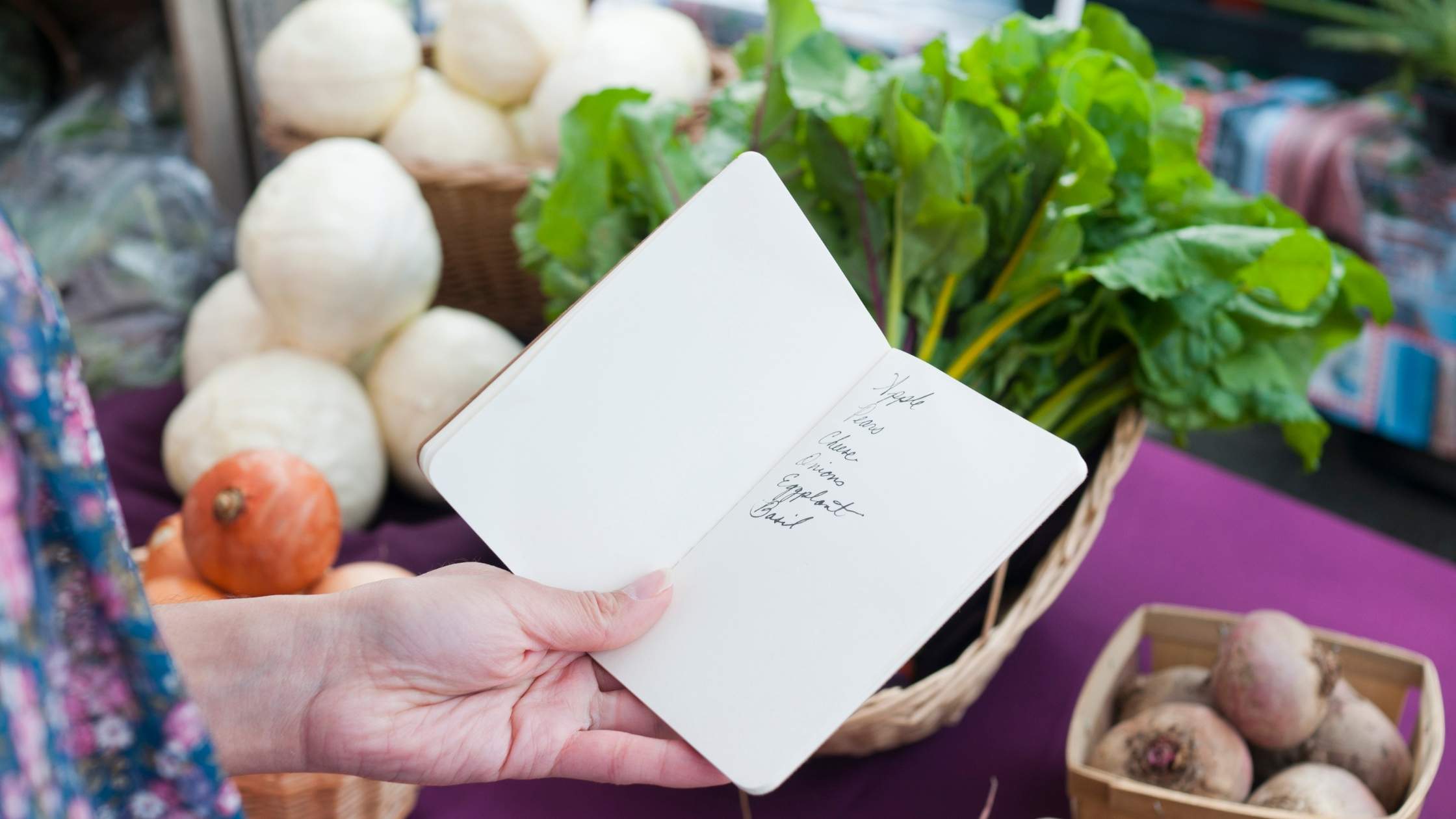
One of the biggest ways to save money on groceries is to know what you’re going to eat. Meal planning is really useful when it comes to making seasonal, inexpensive, real food meals. Having a plan for shopping and cooking, and sticking to it, will help you get a handle on your food budget.
As part of your meal planning look at doing some kitchen DIY. There’s a great book, Make The Bread, Buy The Butter, that breaks down what’s worth it and what’s not when it comes to making things from scratch.
One thing that can be a great way to save money is making your own bone broth, condiments, and salad dressings. When you stop to consider the cost of the prepared items at the grocery store and the pennies it costs to make it at home, all of a sudden it makes sense to take the time to do it yourself.
Consider making meals that you can cook once and eat again is a great way to save money. Simple yet nourishing and delicious foods are a great way to feed your family and manage your grocery budget. Chili, soup, and stew are great choices for this strategy. I’m also a big fan of what I call sequential eating — creatively using leftovers to make another meal. When you meal plan it becomes easy to know what you’re going to make next with your leftovers.
Shopping Tips
Farmer’s Markets
Buying fresh foods, produce, eggs, dairy, and sometimes meat, from a farmer’s market can be another way to get better quality food. This tip may or may not be less expensive than the grocery store however you’re getting truly fresh food and you’re supporting your local farmers. If you buy a large amount of fresh produce from the farmer’s market you can freeze it and have seasonally fresh food out of season.
The Convenience Factor
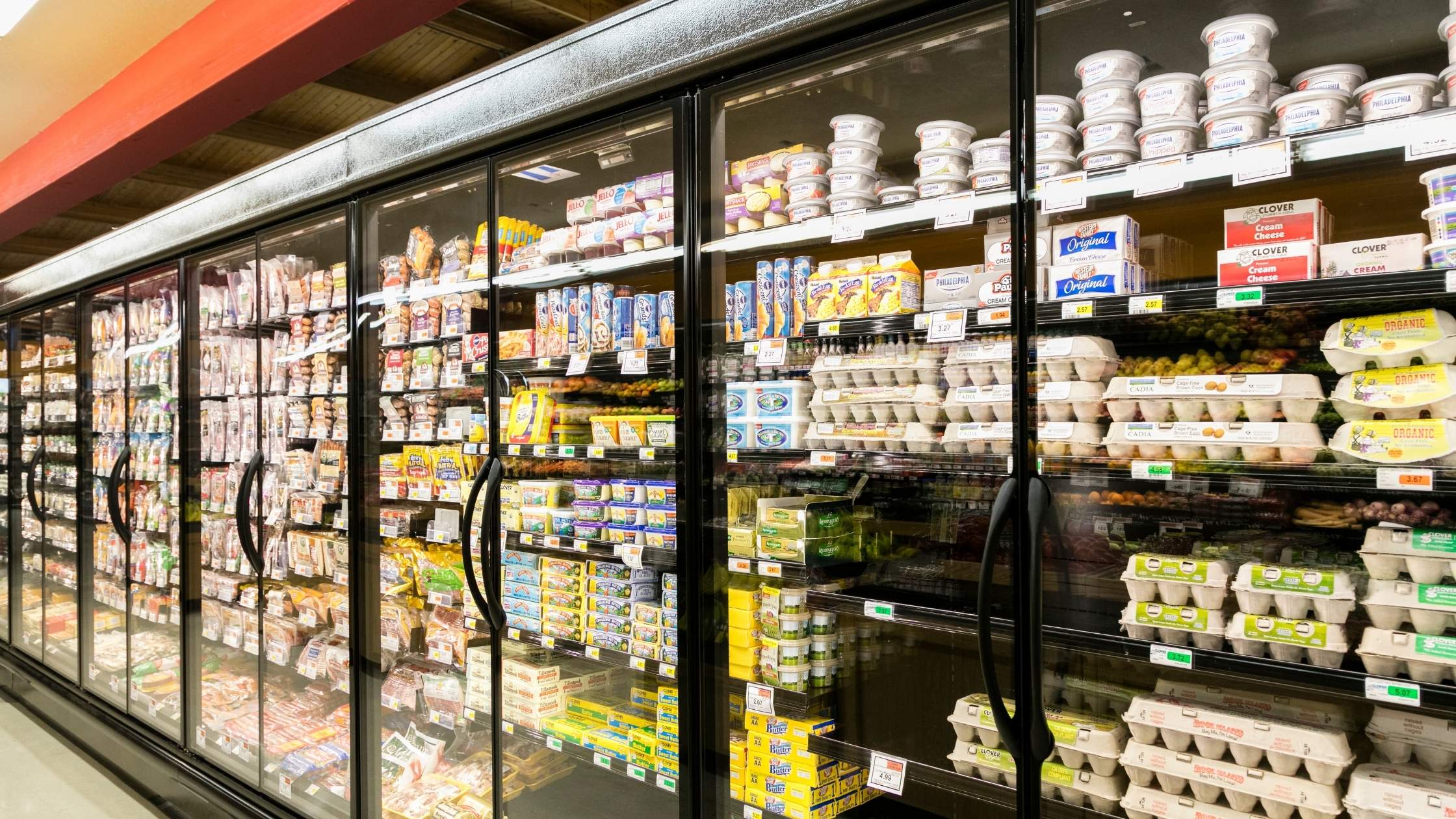
The grocery store and food producers thrive off charging a hefty price to do things for you. Think about if you really need it and/or the convenience it offers. Or can you make it yourself. Pre-shredded cheese for example or pre-cut vegetables are a premium price at the grocery store. You can easily buy a block of cheese or a bunch of vegetables shred/cut it yourself for a big grocery savings.
Get the Biggest Bang For Your Grocery Buck

If you're going to buy organic fruits and vegetables get the ones that really matter, the dirty dozen. Those are the twelve fruits and vegetables that are most likely to be contaminated by pesticides. The grocery store would love to convince you that you need to buy everything organic but that’s not necessarily true. If budget is a factor save your money by not purchasing those organic bananas and buy organic strawberries instead.
Buy Organic Dairy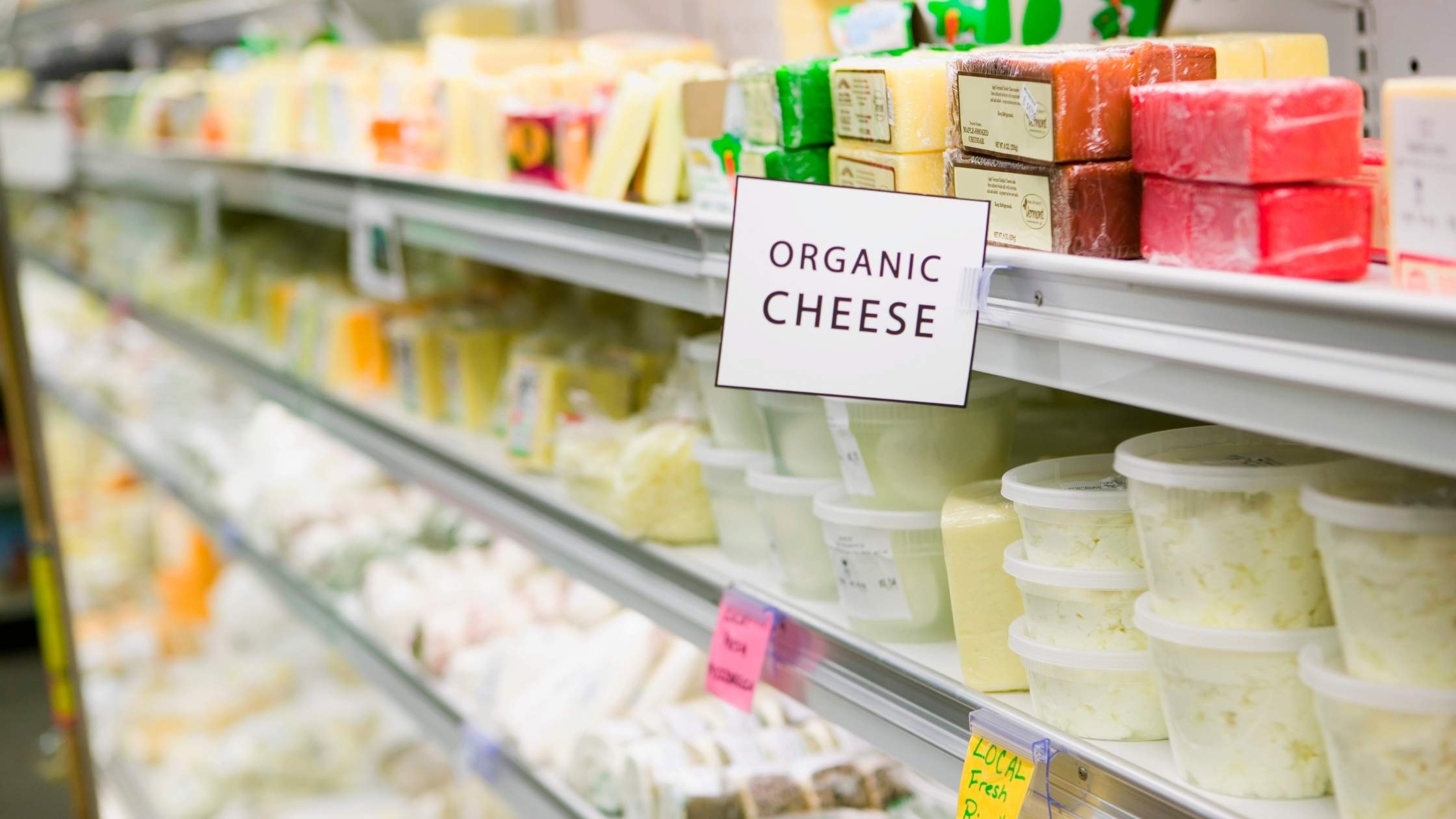
From a health perspective I truly deeply believe that organic dairy is the way to go. It has no added hormones, no antibiotics, and the cows are not fed pesticide-laden grain. What goes into that cow goes into its milk, so it makes sense to not drink or eat those products by choosing organic dairy. Having said that, it's not always easy to find or afford 100% organic dairy products, I truly understand that. If you cannot add organic dairy to your budget it is important that you at least purchase products that are free of rBGH. This hormone was created to make cows give more milk. But it doesn't go away just because the cow has been milked. So we consume it right along with the cheese or yogurt or whatever dairy product we are eating. Check out the RGBH Free Dairy list and see how your brand stacks up.
Buy More Whole Foods
Yes those organic apples may seem more expensive. But how much is that applesauce? And how much more applesauce can you eat than whole apples? Orange juice? Did you know that there is an average of four oranges in one eight ounce glass of juice? That glass goes down pretty easy but I think most people won't sit there and eat four oranges in one sitting. On average the more whole foods you buy the more nutrient dense your dietary intake. Overall this should equate to less money spent at the grocery store.
Eat Less Meat

Somehow we have become convinced that we NEED meat and we have to serve it at almost every meal. Nothing could be further from the truth. Most Americans eat far too much meat. We could stand to eat more beans and other legumes which are a great source of protein with less environmental impact and far less expensive. A package of lentils costs less than a dollar at my local grocery store and makes five cups cooked. That's a LOT of lentils and a lot of protein.
Waste Less 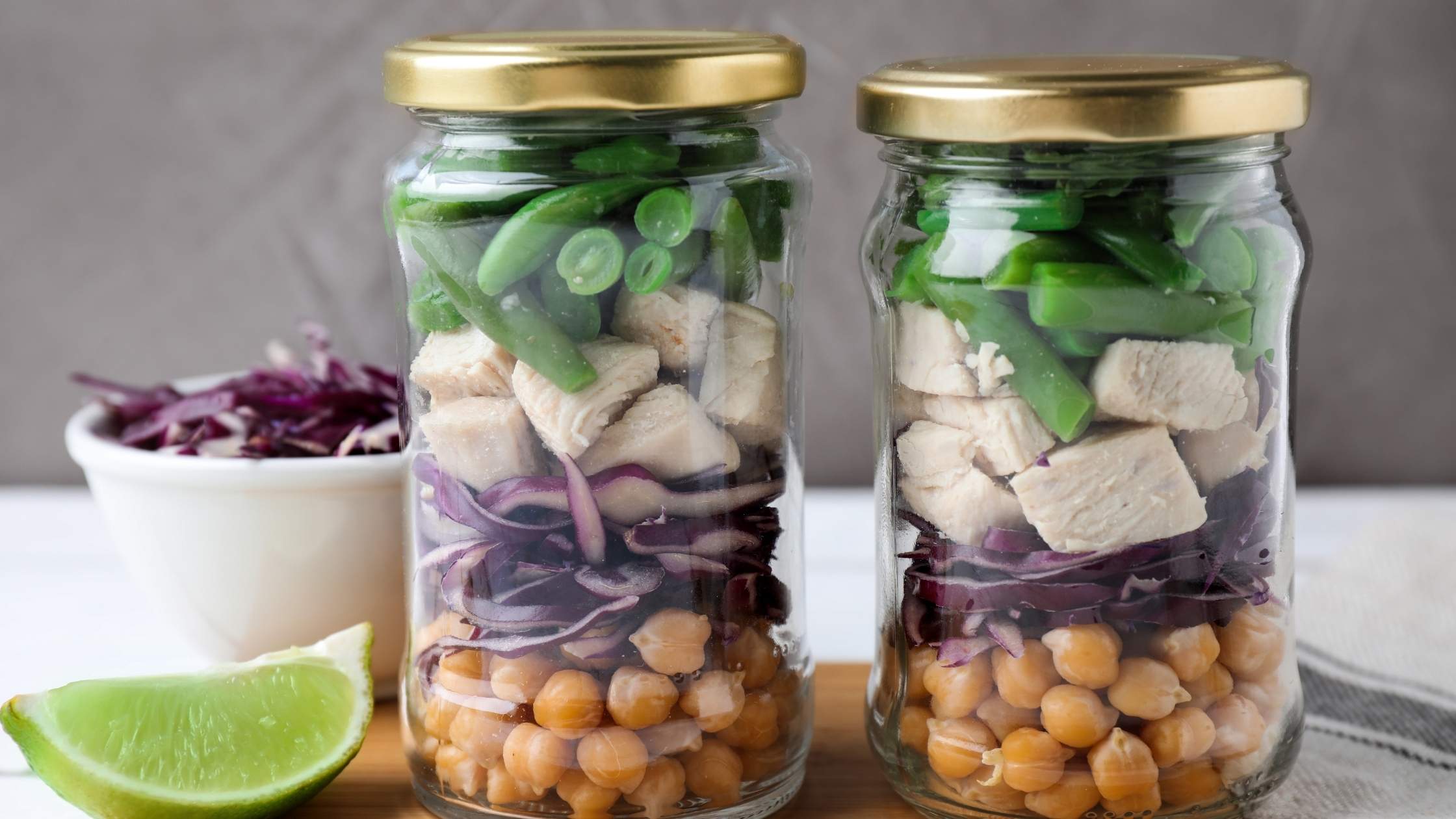
Reducing your food waste is probably the biggest money saver out there. According to the USDA more than one third of the food that is grown is wasted. Some resources put that at more than $1,800 per family per year. That’s a lot of money and lot of food. Stop for a moment and think about how much food you may have thrown out in the last week, two weeks, a month? That's all food that you paid for. You probably even cooked it, increasing its value more as you spent time and energy to create the dish which rotted in the back of the fridge before being sent to the landfill. Planning and being more mindful can help you avoid food waste.
Be Mindful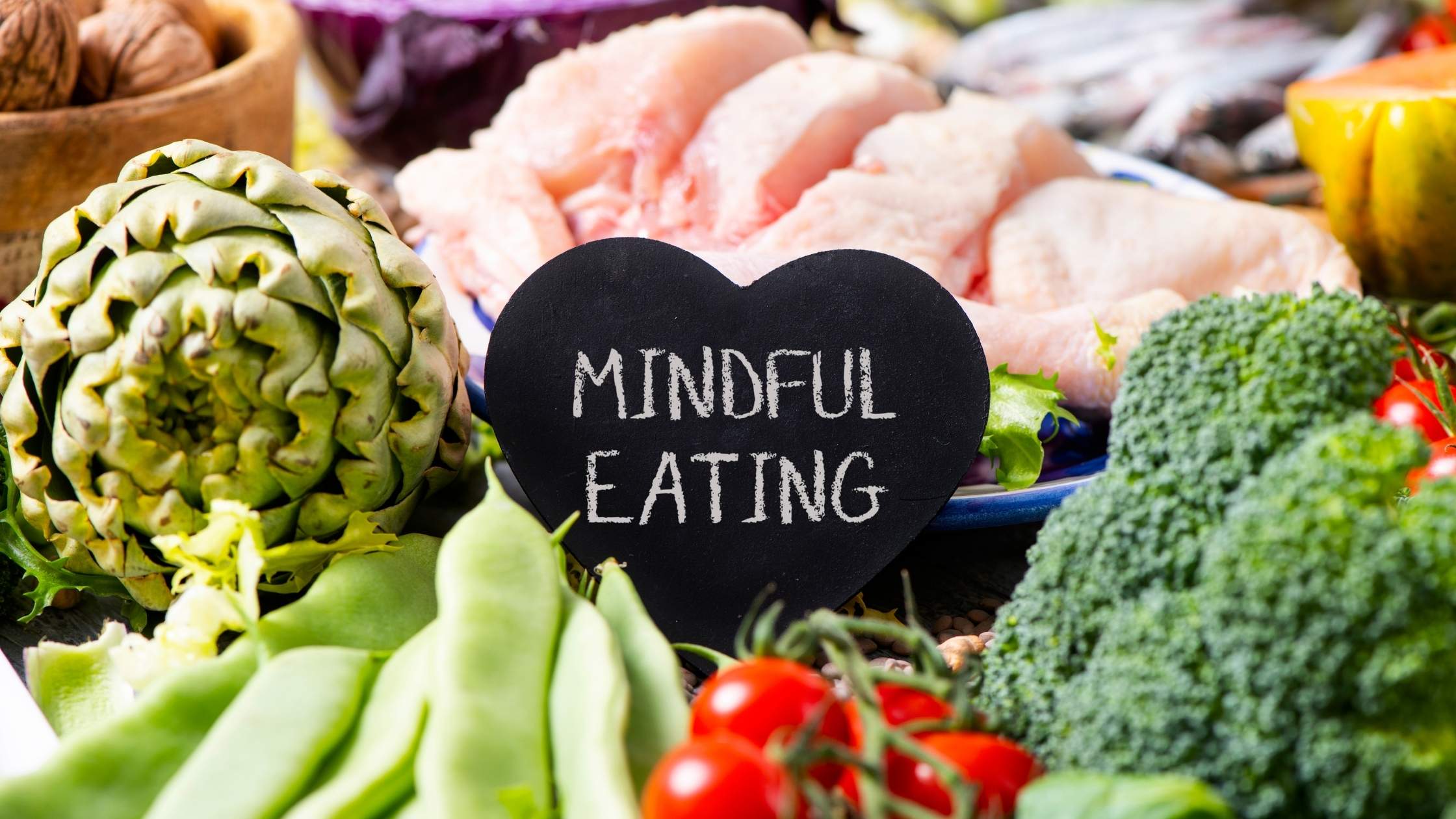
Remember that not every budget will be the same. Food costs vary widely across the country. They also tend to fluctuate with the seasons and availability of certain foods. Then there’s the issue of how many people you are feeding and what their dietary needs are (if there’s a special dietary requirement). Before you begin to look at your food budget, you need to consider all of these things.
Remember also that creating a budget is just one step. Budgets can and do change depending on changes in your family system, income changes, if you are traveling, etc. Once you’ve learned to create a food budget that works for you I encourage you to revisit it at least a couple of times a year to see how you’re doing and if you need to make any additional changes.
Finally, it’s important to remember that if you are making changes to your eating habits and to your grocery budget, you need to make shift gradually and sustainably. Change does not happen overnight. In order to be successful with the changes you are making you want to shift one thing at a time. Once you’ve mastered on change you can make another. Over time you will find that you’re continuing to improve your grocery shopping habits.
Sources
"Over A Third Of The U.S. Food Dollar Is Spent On Eating-Out Services". Ers.Usda.Gov, 2021, https://www.ers.usda.gov/data-products/chart-gallery/gallery/chart-detail/?chartId=58354.
"Food Loss And Waste". Usda.Gov, 2021, https://www.usda.gov/foodlossandwaste.
"Food Waste In America In 2021: Statistics & Facts | RTS". Recycle Track Systems, 2021, https://www.rts.com/resources/guides/food-waste-america/.
State, Chuck. "The Average American Household Wastes $1,866 Of Food Per Year - Futurity". Futurity, 2020, https://www.futurity.org/food-waste-united-states-sustainability-consumers/.
Related articles:
Healthy Budget-Friendly Ideas For When You Hate To Cook
Clean Eating On A Budget
Eight Tips For Easy Meal Planning
What's for Dinner?
It's dinner time. Again. All too often this means a mad scramble to throw together a meal.
In one scenario you're ravenous and in no mood to wait for your food to cook. So you order takeout or eat chips and ice cream for dinner.
Or it's witching hour and you've got hangry family members raiding the pantry for snacks. By the time dinner gets on the table no one is hungry.
You know you need to eat a nourishing diet to be healthy. You also know that when you don't have a plan you're going to reach for whatever is fastest and most easily available. Yet even though you know this it can be hard to change your habits. So you continually find yourself facing one or the other of the above scenarios over and over again.
Meal planning is a vital part of achieving optimal or complete nutrition. If you don't have a plan for what you're going to eat, you will end up grabbing whatever is fastest and most readily available.
This leads to eating an energy (calorie) dense/nutrient-poor diet. That can cause a whole host of health issues like weight gain, headaches, fatigue, bloating, diarrhea, and/or constipation.
So what's the answer? Meal planning.
What is Meal Planning?
You've probably heard about meal planning. And if you're like most people you're envisioning this super-efficient-mad-ninja-kitchen-skills person and immediately discounted the idea thinking that this wasn't you.
Meal planning isn't difficult. It simply starts with deciding what you're going to eat in advance so you're not caught unprepared. By planning your meals you can make shopping, cooking, and preparing food, (and eating), a much simpler and healthier process.
Eight Tips to Make Meal Planning Easy
1. Shopping
There are lots of ways to approach shopping. If you can only shop once a week then you'll want to plan your entire week's worth of meals. If you are able to shop every three or four days then only plan for those days. The trick is to not get too far ahead of yourself.
These days you don't even need to go grocery shopping. Many grocery stores offer curbside pick up where you can order ahead and they bring the groceries out to your car. Other services will actually go grocery shopping for you and deliver to your home.
Both of these services charge a modest fee plus, with the delivery option there is a tip for the driver. But one side benefit of not actually being in the grocery store is the ability to avoid the dreaded $50-Taco-Meat-Syndrome. That's where you run into the grocery store for 'just a second' to get taco meat. And you walk out $50 later.
You'll need to decide if the extra fees are worth the time savings for your family. But deciding your shopping strategy is the first key to success when it comes to meal planning
2. Snacks
All too often when you plan for meals you may forget to plan for healthy snacks. That's one area where you can really tend to let go.
You allow yourself to skip label reading, buy junky choices, and tell yourself that it's okay because 'it's just a snack.' The truth is that if you're going to meal prep and plan to eat well, you want to eat well all the time. If you're looking for a few good snack ideas (and really, who isn't) check out these tasty ideas.
3. Deliciousness
When choosing what to eat you need to make sure it's something that you (and your family) like. You can absolutely choose a bean burger entrée with cilantro lime sauce. But if you don't like cilantro (funny enough there are some people who can't stand cilantro and claim it tastes like soap), or bean burgers, this meal is not going to be a hit.
You will have put all that effort into a healthy meal that no one wants to eat. Not a great use of time, money, or ingredients. Plus then you're probably going to have a science experiment growing in the back of the fridge while you hope that someone will decide they're into bean burgers with cilantro lime sauce. It eventually get's moldy and you have to throw it out.
Choose what you really want to eat, buy good quality, healthy food items, and make sure your recipes and ingredients don't go to waste.
4. Recipes
Speaking of recipes...just because you're going to start a new eating plan doesn't mean you have to pitch all of your favorite recipes.
Yes, you're meal prepping, and that means thinking a little differently. But instead of trying to re-invent the wheel (so to speak) by choosing all new recipes, why not start by simply improving the recipes you already have.
Read the label, choose ingredients that are better quality (for example organic and grass-fed), and avoid additives, preservatives, and other harmful ingredients. If you want to add in a few new recipes that's never a bad thing. Let's face it we all love tasty food.
5. Organize
When you create a system to help you organize and plan, things go much more smoothly.
Figure out what day or days of the week are best for you to go to the grocery store. Make sure that you plan out (meaning write down, don't try to keep it all in your head) a strategy. If you write it down it's much more likely to happen.
So what are you writing down? The following items:
- Your meals and snacks for the week
- The ingredients that you will need to get to make these meals
- When you plan to serve these meals. This is super important. You may make a list of what dishes you think you want to serve, but if you don't identify when you're going to serve them things sometimes don't get made. And that's when we get more of those interesting science experiments in the back of the fride
- What time you plan to go shopping. This is super important. Because you do not ever. Not ever. Ever want to go to the grocery store when you are hungry. If you're ordering ahead like we discussed in #1 above, that's not a problem. But I promise, if you're trying to grocery shop while you're hungry two things are going to happen. 1. You'll buy junk food because your ability to resist is lowered by those hunger pangs and “feed me” hormones. 2. You'll over-buy because...well...you're hungry and everything looks good. Have a meal or a decent snack before you go grocery shopping and you'll do much better. (Plus you'll save money and that's definitely a good thing too)
6. Get help
When you're cooking for your family there is the temptation to simply get meals on the table however you can and as quickly as possible. When you're meal prepping (and to make things easier) one of my favorite tips is to get others involved in meal planning and preparation.
When family members, especially your kids, can take some ownership in the creation of a meal and what you serve they are often more open-minded about what they're eating. If you have more than one child at home you probably want to have just one child at a time in the kitchen unless they're older and work well together. Have each child choose one meal a week that they are responsible for planning and preparing (with supervision).
7. Contingency
Let's face it, no matter how much you plan there are times when something unexpected happens. A change in schedule, an unplanned illness, or some other interruption. In case of situations like this, it's a good idea to have a contingency plan. You may not have any leftovers handy, or perhaps not enough leftovers to feed the family. This is where having something that you can rely on for a backup, without having to fall back on takeout or fast food, will be helpful and ensure you have a nourish meal ready to go.
One backup idea is to have prepared foods available for a simple yet easy-to-prepare dinner such as soup or an omelet. Additionally with a well-stocked pantry, you can create a quick meal in a flash using ingredients you already have on hand.
One of my favorite contingency plans is to have a few make-ahead recipes. These are healthy recipes that you can prepare in bulk, freeze, then prepare for dinner when you need them. I love doing this so much that I created my Fast Fun Freezer Meals program. Using this program you can quickly prep 20-24 servings of dinner at a time. You'll then have meals in the freezer for when you need them.
8. Adventure
Once you have a meal plan it's easy to get into a rut and start to rely on the same thing over and over. While planning provides a framework and makes mealtime easier, it can also start to feel limiting if you're continually following the same plan.
In order to make things interesting, you'll want to mix it up here and there. Not to make it overwhelming, leading you right back to where you started, but in a way that keeps meals interesting and fun. Plan to include one new recipe each week. This provides a little variety and can help you to avoid mealtime boredom.
To get into the flow of meal planning can take some getting used to. It requires you to create some new habits. But, once you've integrated these habits into your routine, you'll wonder how you ever managed without it. It’s a great way to make sure that each meal is nutritious and delicious. And easy.

One Word: Brave
Have you ever picked a word to guide you for an entire year? Just one word. It's easy to create goals or to set intentions (I'm not a fan of “resolutions” you can read why here). Those, however, usually encompass more than just one word. Condensing everything you want for the year ahead into just one word is never an easy task.
For me it requires a lot of introspection. Deeply searching for something that really resonates and helps me grow in some way. The first year I did this practice I discovered how amazing it was to have a word to guide you. I check in regularly with my word and see how things are going. It can be very centering; it's a wonderful way to help you stay on track.
When I began to think about the word of the year this time, I was astonished to see how many words (and how many years) I have been doing this. Previous words have been:
That's a lot of words. As I look over the list I find myself smiling as I remember certain challenges in that year or how that particular word really resonated.
The search for meaning
This year the word found me although I didn't know it at the time. Back in November I was at my friend Doni Langlois' studio to pick up some ceramics. I saw the lovely heart-rattle (the picture at the top) and felt drawn to it so I purchased it as a gift for myself.
In the middle of December as I began my annual word-search process I kept coming back to this beautiful heart sitting near my desk. I thought I wanted a different word but this heart kept speaking to me. Eventually I realized that the reason I couldn't find a word was because this year it was sitting right in front of me.
BRAVE
adjective, brav·er, brav·est.
possessing or exhibiting courage or courageous endurance.
making a fine appearance.
noun
a brave person.
a warrior, especially among North American Indian tribes.
verb (used with object), braved, brav·ing.
to meet or face courageously
to defy; challenge; dare.
It turns out this word is multipurpose, being a verb, adjective, and a noun. As I think about it I realize that I am setting a big intention out there in the world by choosing this word. I asking myself to:
- be brave, to stand up to those things or situations that make me nervous or fearful
- to dare to speak out with courage where necessary
- to endure
I know that although the way doesn't always seem so clear at the beginning of the year when I pick my word, as the year progresses the word always seems to resonate throughout all aspects of my life.
Join me
What's your word? What intentions are you setting as we move forth into this shiny, sparkly space of new year? I'd love for you to join me by choosing your own word. If you want you can even join a word tribe over at OneWord365 and see who else has picked the same word.
What ever lies ahead, my wish for you is one of peace, happiness, and good health. Be well.
10 Ways COVID-19 Has Changed The Way We Purchase, Prepare, And Eat Food
Starting back near the beginning of 2019, there have been a large number of changes in daily life. One of the biggest is how people function in their kitchens.
According to the International Food Information Council’s (IFIC) 2020 Food & Health Survey, 85% of Americans have changed not only how they obtain and prepare their food, they’ve also modified their mealtime habits.
Some of these food habit changes are good, healthy choices. Other habits, such as increased snacking, eating when bored, and inconsistent mealtimes, aren’t so great.
Because we have no idea how long the current situation will last, we don’t know if the differences in shopping and eating habits will be a relatively short-term thing or if they will continue and become a long term trend.
In this article, I want to focus on positive trends. The goal here is for you to implement these in your own life. Hopefully you’ll take it one step further and share these items with your family and friends to encourage them to make more positive changes in their own food habits.
1.Healthy snacking- 32% of Americans shared that they are snacking more on fresh produce. Given that you should have 5-7 servings of vegetables a day, snacking can be a good way to get more veggies and less chips or other simple carbs into your diet.
2.Home cooking- 60% of those surveyed claim to be cooking more at home. This is a good way to ensure that everyone is getting whole, real foods and managing serving sizes. This can also be a good opportunity to share healthy recipes with your family.
3.Home baking – Since we started sheltering in place, the demand for flour and yeast rose. Being stuck (and safe) at home has inspired many parents and their children to bake. This is evident on Instagram, as photos of #bananabread and #sourdough starters have become viral with a whopping 5.6 million hashtags combined, as of Nov 21, 2020.
4.Eating together – Up to 41% of people shared that they make communal mealtime a priority now instead of everyone eating individually and/or grabbing meals on the run. It’s also the perfect time to share fun ideas for conversation starters with your loved ones.
5.Decrease in frequency of eating out – More than 80% of US consumers have anxiety about dining in casual and quick-service restaurants. And foot traffic to the quick-service restaurants has continued to decline since the US has declared a national state of emergency.
6.Prioritizing health – Approximately 70% of respondents said they’ve begun to make health and healthy habits a priority since the pandemic started, whether that’s been getting more exercise and sleep and making positive dietary changes.
7.Cooking new family recipes – In an article by New York Post, almost 30% of people mentioned that they have learned how to cook a new family recipe. A further 38 percent of these respondents shared that they’ve been able to enjoy more quality time with their loved ones.
Recipes are part of a family tradition; being able to share them also shares the connections to the generations that came before us, and the culture that the recipe came from.
8.Eating local – Consumers, aside from knowing where their food comes from, are also looking for food to support the local community. And this desire has increased by 430% during the pandemic.
9.Growing your own “victory garden” – More Americans are also learning how to grow their own food and plant their own “victory garden.” Even if it’s simply potted herbs on the kitchen counter, a planter with tomatoes, or a fruit tree, they’re reconnecting with their food at a more basic level.
10.Online shopping for groceries – The online grocery business continues to grow significantly. Estimates are that by 2025, 20% of all grocery dollars will be spent online, with this segment of the market valued at an estimated $100 billion.
Just as food producers and grocery stores work hard to create marketing that entices consumers to buy from brick and mortar businesses, they’re now working equally as hard to grab their share of this growing sector.
I continue to learn about the things food producers, advertisers, restaurants, and grocery stores do to manipulate and confuse you so I can help you stay one step ahead.
Take a moment to look at how your family food culture has changed. Hopefully, from meal preparation to time spent eating together, you’re focused more on food as a communal time to reconnect and nourish together.
As a nutrition professional, I’d love to hear what has changed in your kitchen or your family’s eating habits over the last eight months. I hope you’ll take a moment to share with me.
Sources
Turn Your To-Do List Into A Ta-Da List
I’m a fan of using a bullet journal. It really helps me to stay on track, keep thoughts organized, and is a flexible planner for how my brain works.
One thing I have in my journal is a Ta-Da List — a rolling list of what I did/completed each day. It’s not a To-Do list. It only gets written after things are done. And there are a couple of reasons why.
1. It allows me to see where my time went and, if needed, to adjust my schedule.
For example, at one point I saw that I was getting a lot of unscheduled phone calls (when I have phone calls or meetings I log them plus the amount of time I spent on the call). I then shifted to make Tuesday and Thursday morning phone call times and started telling everyone.
I also set a mental limit on how long I would be on the phone for unexpected phone calls. Letting the caller know that “I’m at work and only have 15 min”. It really helped. Like many in this group, often those who have my phone number seem to think, even though they know I’m self-employed, that I’m always available.
2. I also evaluate other tasks to see if there is a way to improve or make them more efficient.
If there are certain tasks that are repetitive can I automate them? Are there things that I am doing that might be better to assign to a team member? Are there hints I do that I just shouldn’t be doing at all m
3. I can see how long certain tasks actually take.
I use the Pomodoro method to notate how many units each task took. I tend to suffer from what I call time suck disorder. I don’t always realize how long things are going to take. Time management and time flow awareness are one of the difficulties faced by people with ADD. It can get in the way of productivity and a balanced focus. So it’s challenging when I plan for something that doesn’t happen in the time frame I’ve allotted. My Ta-Da list reminds me of what I did get accomplished and has helped me learn to shift my time thinking.
4. I get the satisfaction of getting things done and seeing them in the list.
All too often, when I was doing only a traditional To-Do list, I would be discouraged. Yes, I got things done, but the number of unchecked boxes was overwhelming. Now, borrowing from Brendan Burchard’s High-Performance Planner (which I still use every day also) I track the three most important things that have to be done for the day. This means no. Ore endless to-do lists. It forces me to focus on what HAS to be done. The rest of it is being aware of what I’m doing.
In my opinion, using a Ta-Da List has made my life much more streamlined, easier to pivot where needed, and less stressful.
Who in this group also uses a bujo?

